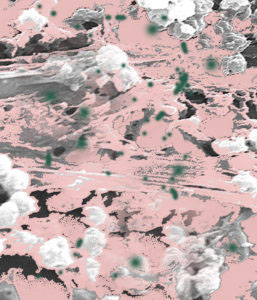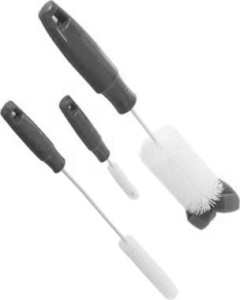Cleaning Slime From Your Plastic Pet Fountain
The technical term for the slime that inevitably builds up in plastic pet fountains is ‘biofilm’.
Regardless of where the biofilm-causing bacteria originate – the air, your pets mouths, the environment generally – the buildup of this bacteria is exacerbated by the plastic, which seems to be one of the favorite colonizing materials for slime bacteria. Further, plastic inevitablty becomes scratched and in those scratches the bacteria can, and really do, thrive. If you are finding it very difficult to clean biofilm off your pet fountain then you are probably using a plastic pet fountain. Unless you use bleach or some other powerful chemical agent, regularly, the bacteria will build up, creating an unhealthy environment that can cause a number of ailments for your pet and you.
Associated diseases from slime in plastic pet fountains
Chin acne on your pet is the most commonly reported consequence of this bacterial buildup. A recent study conducted by the National Sanitation Foundation (NSF) concluded that pet bowls are the fourth leading source for places in the home that contain the most germs. Several manufacturers include cleaning equipment with their fountains (which says a lot) but unless these are used scrupulously and assiduously, they will  not be adequate. And using them can be difficult and is time consuming.
not be adequate. And using them can be difficult and is time consuming.

Can biofilm be prevented or eliminated from plastic pet fountains?
To a degree, there are a few things you can do if you own a plastic pet fountain to eliminate and prevent the build-up of biofilm and that involves cleaning. There are some additive agents that can be added to your pets’ water but these seem of dubious value and can be expensive.
As previously mentioned, you must regularly clean your plastic pet fountain with bleach or some similar chemical, then rinse very thoroughly. (Your cat won’t go near the fountain if it has even a touch of bleach smell to it). Unfortunately, the real and best answer is, don’t use plastic pet fountains. Yes, you paid good money for them and oh yes, your pets may love their plastic fountain (which is because they love flowing water) but they won’t associate their pain and discomfort and sickness with their drinking source. Which is why we must. It is a simple and unavoidable truth that plastic is not the material pets’ fountains should be made of.
Are There Dishwasher Safe Plastic Cat Fountains?
The short answer is No. Here’s why:
“For safety’s sake, certain plastics shouldn’t be washed in a dishwasher. “A dishwasher’s heat can cause harmful chemicals such as phthalates and BPA to leach from plastics that contain them,” says Don Huber, director of product safety for Consumer Reports.
Below are reviews on Amazon of one of the leading brands of plastic pet fountains.
“While the unit continues to operate flawlessly, I notice the water is very slimy when I clean it. It only takes the water a couple of days to get like this. No one in the online forums seems to know how to get rid of this. I called (redacted company name) and they advised running vinegar through the fountain which I did for several hours. Tried again this week, the cat won’t go near it, and the water is slimy again. I tap out.”
“If you like cleaning slime every week this is for you.
We bought this and the cats loved it, the problem is that it builds up a bacterial slime on every part and it has to be taken apart and washed every week. This is a half hour process leaning over the tub, trying to clean the motor out with the little brushes that are sold for it. We have tried multiple times to run it through the dishwasher but it does not clean all of the scum off this as it can not go onto the hottest setting which is the only thing that would work but that would melt or cause the plastic to get brittle.
Now this sits in a corner of the bathroom, it has not been run in over 6 months and I am considering putting it out at the next yard sale!”
So all those ads you see for ‘the best cat fountain’ and ‘the best pet fountains’ which feature plastic fountains are bogus, probably funded by the manufacturers themselves. They are, in fact, the worst possible choice and people need to know this.“I had two fountains previously, one plastic & one metal with a few plastic parts, that I threw out because they would get slimy.”
The Environment
Then we need to consider the environment. The process of manufacturing plastic deteriorates the air quality considerably. What’s more, every plastic pet fountain sooner or later and often sooner, ends up in a landfill. And this is so unnecessary given the availability of quality ceramic fountains which last a lifetime. ThirstyCat fountains, in the long run, are less expensive than plastic fountains, not just because they last a lifetime but also because of superior filtration which lasts more than a year rather than 3 weeks as is the case with most Chinese made fountains. Ceramic is clearly best. But beware of ‘ceramic’ pet fountains made in China. They are made of low density clay poured into molds and glazed with low-fire glazes. Who knows what’s in the them. Ceramics is not strictly regulated for food-safety in China as it is in the US.
The best choice to avoid biofilm
Veterinarians recommend high-fired ceramic first for pets’ water bowls and fountains. (ThirstyCat Fountains are fired to 2,232 ℉). Vets’ second choice is stainless steel, although this may not be your pets’ second choice as there can be a metallic taste with stainless steel. The reason both these materials is safer is that neither are porous and don’t get scratched. Thus they don’t provide a suitable home for bacteria.
But be vigilant. All the metal pet fountains we’ve seen have an abundant amount of plastic submersed in the water. Also, most ceramic pet fountains are made in countries which do not regulate the use of harmful minerals (lead, cadmium, etc.) in ceramics. You don’t know if those materials have been used in the ceramic pet fountains they make and you also don’t know if they were high fired, which is, in fact, unlikely, as this requires a great deal more fuel (greater cost).
Only if the maker of the fountains makes the glazes themselves and certifies that no harmful minerals are used can you be sure. Your best bet then is to buy ceramic pet fountains from reputable fountain creators in the United States. Those who make their own glazes and know what is in them. ThirstyCat Fountains is one such company. If you’re still not convinced, please read any of many reviews which speak of the differences between our fountains and pet store brands.
Here are the words of a customer she sent along with a video of her cat Jayden:
“HiHere is a video of Jayden enjoying his fountain.I really love your fountains. They are absolutely the best. The materials you use are top quality for the health of the cat. The designs are beautiful, unique and are truly a work of art. I also love the personal service you offer to each of your customers. You are always prompt in responding to any question I have ever needed answered. Never change how you do business. You are top notch.Yes the original investment for your fountains seems high. But your fountains last years. I replaced my first one because I dropped it and it broke. That was after years of use. I’ve had my second one for maybe 5 years with absolutely no problems at all.I clean it once a week. Takes me about 10 minutes because I take all the pieces apart and clean each one. Simple.Thank you for making such a great product. The quality and designs are outstanding.”
